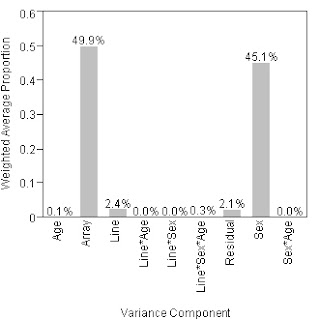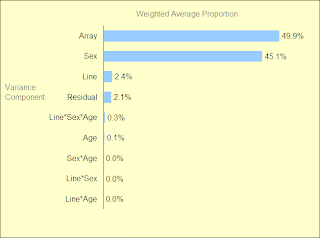www.bzintelguru.com
Thanks.
Monday, July 6, 2009
Thursday, May 14, 2009
Let's bar the pie chart, a response to Russ' JMP blog post
In a blog post on JMP, Russ Wolfinger makes a case for 3D pie charts over. His rational is this,
"It [the 3D pie chart] takes advantage of color, aggregation and 3-D aesthetics. The labels enable immediate identification with the data instead of forcing me to eyeball down to an X-axis and tilt the head to read them. In addition, blogosphere exigencies require omission of a critical feature: interactivity. It’s a spinnable graph that comes complete with slider bars that let you adjust degree of explosion and shininess. (Thanks to JMP experts Xan Gregg, who has written about 3-D pie charts in JMP, Craige Hales and David Barbour.) The ability to personally control the graph won me over. Graph B also appears to be better suited for rapid scan viewing as recommended by Bill Cleveland."
On aesthetics the 3D pie chart is hard to look at because it's unprofessional looking. The reflection of light off the pie pieces is silly, the thickness of the pie pieces is meaningless, and the bevel of the edge of the pie takes the cake. I feel bad for the graphics card that had to render all that junk. All of these things detract from the message that the poor pie chart is trying to convey.
The label comparison problem on the bar chart can be easily fixed by flipping the chart, as I've done below.
As for interactivity, it's hard for me to image that consumers of the chart will want to play with it. What is more important is that the person presenting the graph take the time necessary to get it right, so that their audience doesn't need to spin it or alter it with sliders. As for the preparer needing sliders and spinners, perhaps that is useful, but on a pie chart? Doubtful.
So, here are the 3 charts.
First, the bar chart that Russ doesn't like.

And here's his improved pie chart
Finally, my version of what his bar chart should look like

Tuesday, May 12, 2009
Shift Happens, updated
I stumbled across this an earlier verion of this video a few months ago. Now it's been updated.
I think this is a novel approach to info vis, basically well designed slides as a movie. How many stats from the movie do you remember?
Monday, May 4, 2009
Times Swine flu map-update
They added a time slider to the map, but kept the circles.
Related story in today's paper about how students at Northwestern are building a model using the physical path that dollars take, plus air traffic and commuter data, to predict the spread of the virus. So far, their predictions have been fairly close. They estimate, without the US taking preventative measures, a total of ~ 2,500 cases in the US. Not too bad in a country with 300,000,000 peeps.
Friday, May 1, 2009
NYTimes lame Swine Flu map
Check out the map the NYTimes put out showing where the swine flu has struck.
Typically, the GIS Team at the Times does great work with maps, using timeline sliders, and appropriate levels of granularity to best tell their story. This time, however, I think they've fallen short. First off, rather than using circles, which we all know are almost impossible to compare to one another, why not just fill in the states and countries with the appropriate color shades showing the number of cases? Or, better yet, go granular and show the data at county/province level.
Here's an old map from NYTimes showing state and county level voting results over time. You can select which view you want from the menus on the left side of the map. I think this approach would be better for the flu map, as there's a time component they could use to show the spread of the flu. In addition, the county/province level would provide a clearer picture of the exact places impacted by the flu. For example, in Mexico, are most of the cases in Mexico City, or some other part of the country?
Wednesday, April 8, 2009
Tuesday, April 7, 2009
Putting a scan to a face
Here's a link to a story about how putting a face on a CT
scan leads the people who review the scans to pay
more attention to them.
After months of reviewing CT scans with patient photos
on them, do the reviewers continue spending more time
on them? Or do they fall back to their previous levels?
Subscribe to:
Comments (Atom)
